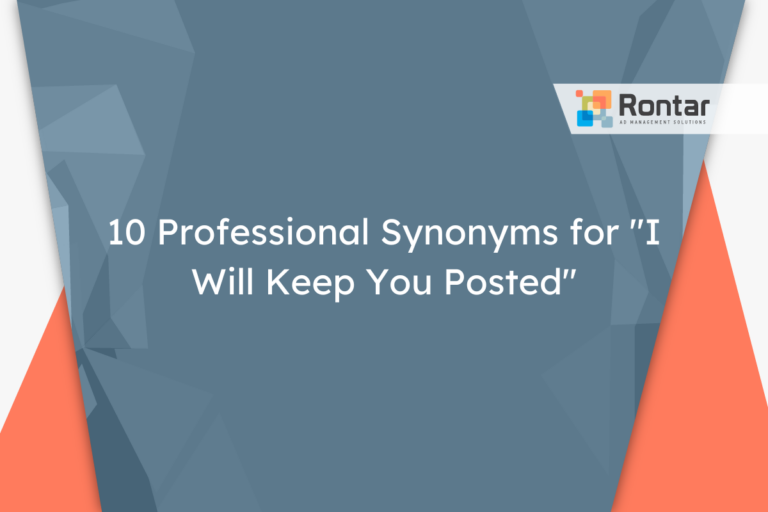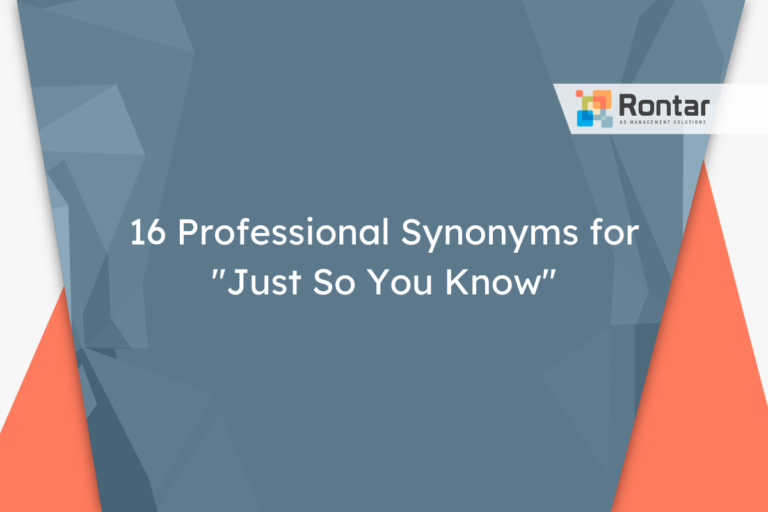10 Professional Ways to Say “I Just Wanted to Follow Up” in an Email

In the professional world, it’s important to keep the conversation going, especially through emails. Sometimes, you need to remind someone about a project, a meeting, or just to get an update. Using the same old phrase, “I just wanted to follow up,” can get boring and less effective.
We have compiled 10 alternative phrases that are professional and can help make your emails stand out.
Is It Professional to Say “I Just Wanted to Follow Up”?
When it comes to professionalism, the phrase “I just wanted to follow up” is often seen as professional, formal, and polite. It’s a way to remind someone about something without being too pushy. This phrase is perfectly suitable for a workplace setting where you need to remind colleagues, clients, or partners about meetings, decisions, or any pending tasks that need attention.
It’s mostly used after you’ve had a previous interaction or communication about a specific topic or task, and you’re awaiting a response or an update. For example, if you sent an email proposing a meeting time and haven’t heard back, using this phrase is an appropriate way to remind the recipient.
Dear Samantha, I hope this email finds you well. I just wanted to follow up on my previous message regarding the marketing meeting next week. Are you available to discuss the agenda and confirm your attendance? Looking forward to your response. Best regards, Michael
Pros:
- Shows you are engaged and genuinely interested in progressing.
- Keeps communication open and professional.
- Helps in gently nudging the recipient towards a response without being too forceful.
Cons:
- Can be overused, potentially leading to the recipient ignoring the email.
- If not used sparingly, it might come off as impatient.
- Some recipients may find it too formal in less traditional industries.
Even though this phrase is widely accepted and professional, some might consider using an alternative, especially if they’re looking to stand out or approach the follow-up in a different manner. Finding synonyms or other alternatives can freshen up your communication and might be more appealing in certain situations. Whether you decide to stick with this familiar phrase or venture out to use synonyms depends on your relationship with the recipient and the context of your email. Either way, it’s always good to have alternatives in your back pocket to cater your communication more precisely to each unique scenario.
10 Other Ways to Say “I Just Wanted to Follow Up” in an Email
Looking for a change in your email language? Here are 10 professional alternatives to refresh your follow-up messages:
- Touching base on
- Following up on our previous conversation
- Checking in on
- Just checking to see where we stand on
- I wanted to see where we are with
- Inquiring about
- Seeing if there’s any update on
- Wanted to ask about the status of
- Reaching out about
- Just wanted to remind you about
1. Touching base on
The phrase “Touching base on” is a more informal yet still professional alternative to “I just wanted to follow up.” It implies a friendly check-in without pressuring the recipient. This makes it great for maintaining a positive and light communication tone, especially in industries that value casual yet professional interactions.
This alternative is better suited for messages where the relationship between the sender and the recipient is well-established and slightly informal. It keeps the conversation light and friendly while still focusing on the matter at hand.
Here’s a sample usage:
Dear Alex, Hope you're doing well. Touching base on the project proposal we discussed last week. Do you have any updates for me? Best, Patricia
2. Following up on our previous conversation
This phrase is a formal and professional way to remind the recipient about a recent discussion or agreement. It’s particularly useful in contexts where the follow-up is tied directly to a conversation or meeting that took place. This wording reinforces the continuity from the previous interaction.
It is ideal for situations where the follow-up needs to emphasize the importance of a prior discussion. This ensures that previous conversations are built upon and not forgotten, keeping projects or agreements moving forward.
Here’s an example:
Dear Marcus, I hope this message finds you well. Following up on our previous conversation, have you had a chance to review the documents I sent over? Kind regards, Emma
3. Checking in on
The phrase “Checking in on” carries a polite and somewhat informal tone, suggesting a gentle reminder without implying urgency. It’s perfect for when you want to keep the message friendly and lower the pressure on the recipient, but still aim to get an update or response.
It works best in scenarios where there’s an established rapport or when the inquiry is of a less urgent nature. This alternative helps to foster goodwill and maintains open lines of communication.
Sample message:
Hi Jordan, I hope you're having a great day. Checking in on the budget approval for next quarter. Any news on your end? Cheers, Taylor
4. Just checking to see where we stand on
This alternative is informal and polite, suggesting a friendly nudge for an update. It’s an excellent choice for ongoing projects or discussions where periodic updates are expected. It’s less about demanding an immediate answer and more about mutually understanding the current situation.
This is particularly apt for long-term projects or when you want to convey patience and understanding, showing that you’re mainly interested in progress, not pressuring for immediate results.
Use it like this:
Hello Vanessa, Just checking to see where we stand on the venue booking for the event. Any progress? Best wishes, Liam
5. I wanted to see where we are with
This phrase is a professional and slightly formal way to ask for an update without sounding impatient. It’s similar to “Just checking to see where we stand on” but with a bit more formality, making it suitable for professional settings where you have a respectful but not overly familiar relationship with the recipient.
It’s excellent for use in situations where there’s been some prior discussion or activity, and you’re seeking an update on the current status or progress, especially when dealing with timelines or deadlines.
Here’s how it can be used:
Dear Jamal, I hope all is well. I wanted to see where we are with the project timeline we discussed. Any updates would be greatly appreciated. Sincerely, Diane
6. Inquiring about
“Inquiring about” is a formal and professional synonym that fits well in more official or formal email correspondence. It signifies direct interest in a specific area or topic without implying any neglect on the part of the recipient. It’s direct yet courteous.
This alternative is best suited for communications where clarity and directness are valued, and where the topic of inquiry is of significant importance or urgency to the sender.
An example is shown below:
Dear Connor, I am writing to inquire about the status of the annual report submissions. Inquiring about any updates you have. Regards, Sophie
7. Seeing if there’s any update on
This phrase is a polite and informal alternative that implies you’re casually seeking information or an update without demanding it. It’s great for creating a friendly atmosphere in your emails while still getting to the point of needing information.
It’s perfect for when the relationship with the recipient allows for a more casual approach, or when the topic of the email isn’t urgent but still requires a follow-up.
Use it in a message like this:
Hey Taylor, Hope you're well. Seeing if there's any update on our lunch meeting next week. Still good for Tuesday? All the best, Jordan
8. Wanted to ask about the status of
This is a formal and professional way to inquire about progress or updates. It indicates a clear desire for information regarding the status of a particular issue, project, or task without applying unnecessary pressure on the recipient. This phrasing shows respect for the recipient’s time and efforts.
This phrase is particularly useful in professional settings where deadlines are approaching, and you need to get a status update without sounding too harsh or impatient.
Here’s a sample use:
Dear Rebecca, I hope this email finds you well. Wanted to ask about the status of the contract review. Are there any sections that need further clarification? Kind regards, Eric
9. Reaching out about
The phrase “Reaching out about” is a polite and professional choice that conveys a sense of initiative and willingness to engage in a dialogue. It’s ideal for when you want to highlight your proactive approach in seeking information or clarification on a matter.
This alternative is suitable in situations where establishing or maintaining a connection is key, like when networking or when you’re starting a conversation with a new contact.
An example message:
Hello Samantha, Reaching out about our meeting proposal. Do you have any preferred dates and times? Best, Oliver
10. Just wanted to remind you about
The phrase “Just wanted to remind you about” is a polite and somewhat informal way to follow up, emphasizing the reminder aspect of the message. It’s especially useful when the recipient has previously agreed to do something or when a deadline is approaching. This wording helps to nudge without being annoying.
It fits best in scenarios where there’s an agreed-upon action or deadline that is coming due. It serves as a gentle reminder to help keep things on track without seeming too demanding.
For instance:
Dear Henry, I hope you're doing well. Just wanted to remind you about the report due next Monday. Let me know if you need any assistance! Warm regards, Nina
Final Thoughts
Changing up the language in your emails can make a big difference in getting the responses you need. The 10 alternatives we’ve shared are great tools for keeping your emails fresh and engaging.
Remember, the right phrase can show professionalism and warmth, pushing your messages to the top of someone’s inbox. Using these alternatives also helps in building better relationships through your emails by making them seem less robotic and more personal. So, try out these options and see which ones work best for you. After all, effective communication is key in any professional setting.






